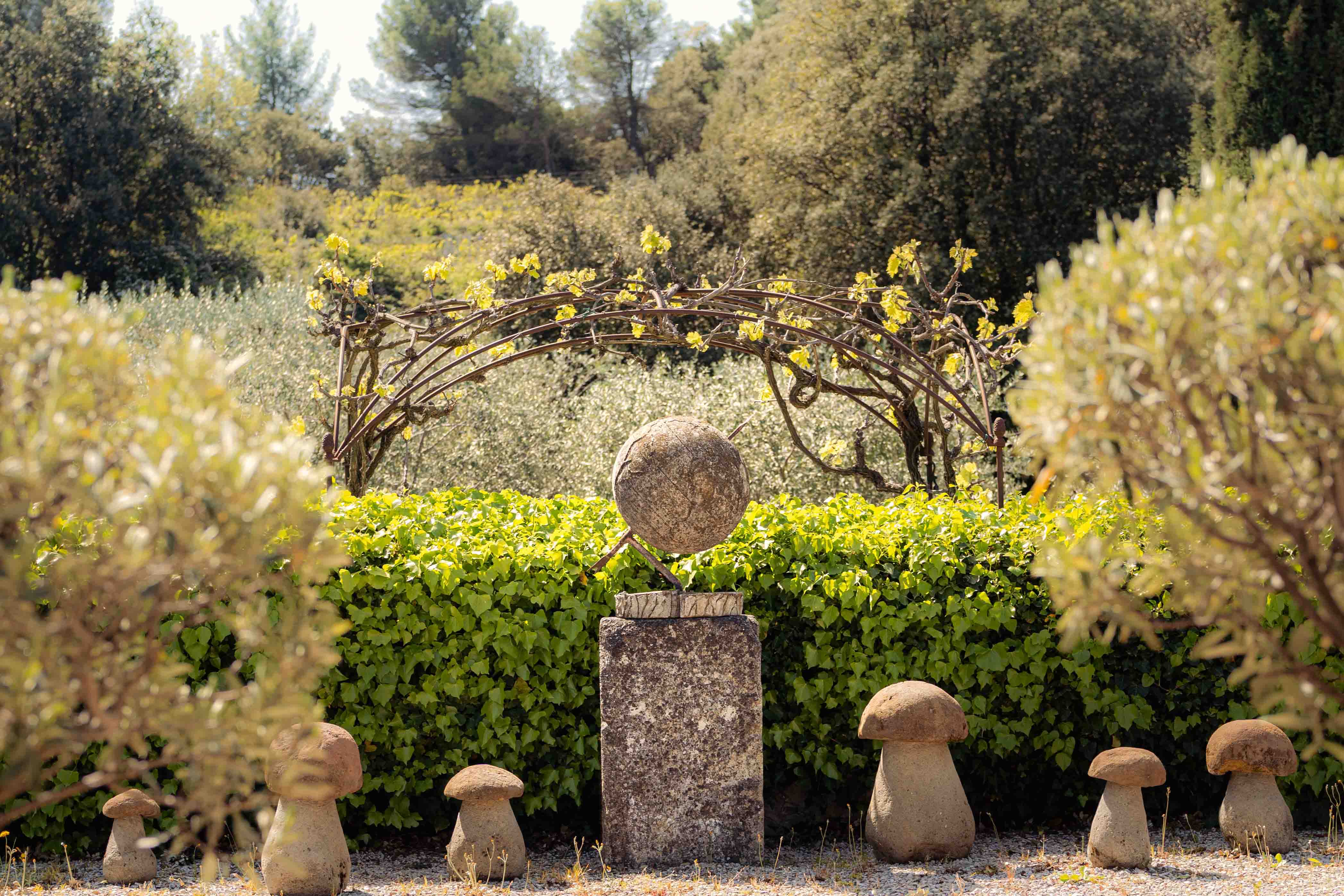
8 ways to create your French garden
Transform your garden into a timeless French retreat with these eight curated design ideas. From the elegance of symmetrical layouts to the charm of antique stone planters and iron accents, each tip captures the essence of classic French style.
Tip number three is particularly effective for bringing an effortless touch of sophistication to your outdoor space.
Explore the images below for inspiration drawn from the most enchanting French gardens—whether it’s the grandeur of a countryside estate, the romance of a Parisian balcony, or the tranquility of a Provençal courtyard. Discover how to create a chic, authentic French atmosphere in your garden.




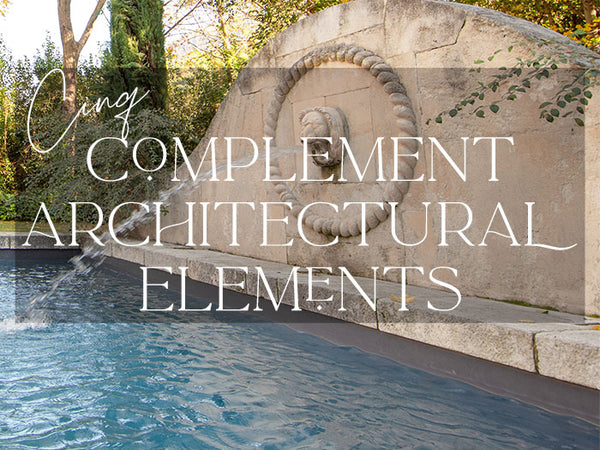

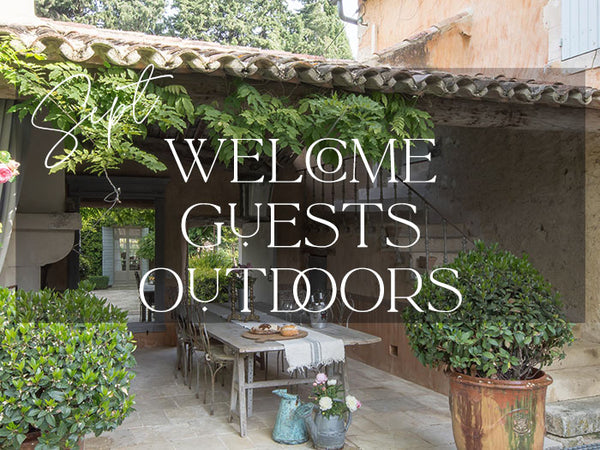


1. Display traditional planters
French gardens, whether grand or modest, often feature stunning planters that enhance their charm. From formal classical designs to more modern styles, these garden accents come in a variety of sizes, colors, and materials, offering endless options for those seeking to elevate their outdoor spaces.
Cast iron Medici urns, with their classic and timeless appeal, bring an air of sophistication to any setting. Meanwhile, antique French planters showcase extraordinary patinas, telling stories of their origins and embodying the unique craftsmanship of the regions where they were created. These planters are not just functional; they are exquisite works of art that blend seamlessly into both traditional and contemporary gardens.
Meticulously crafted by hand since the eighteenth century, Anduze urns are made from terracotta and adorned with sculptural garlands, finished with green and yellow glazes. Traditionally, these urns were used to plant citrus trees. Prior to planting lemon, lime, orange, or kumquat trees, it's essential to assess their suitability for your climate or be ready to provide shelter, such as a glasshouse, during the winter months.
You can combine and blend antique Anduze urns, or select your size, design, finish and quantity from our exquisite range of artisan made Anduze urns.
Enhance architectural features such as doorways, garden gates, or pathways by flanking them with antique and vintage pots planted with lush evergreens. Unglazed garden planters bring a timeless appeal to any outdoor space, as their natural surfaces weather beautifully, developing rich patinas that only improve with age. These planters effortlessly blend functionality with aesthetic charm, making them an ideal choice for creating a classic, curated garden design.
To create a naturally aged look on terracotta planters, you can stimulate moss growth using this tried-and-true method. Blend live moss with a small amount of milk, yogurt, or beer in a blender to form a thick paste. Using a brush, apply the mixture evenly onto the surface of the terracotta planter where you want the moss to grow.
Place the planter in a cool, shaded area, as moss thrives in low-light, damp conditions. Keeping the planter consistently moist is key—use a spray bottle or water sprinkler to mist the surface regularly, ensuring it stays damp but not overly saturated. With time and proper care, the moss will take hold and grow, giving your planter a beautifully weathered, timeless appearance.
2. Choose iron and marble furniture
The allure of French garden furniture lies in its superior craftsmanship, timeless design, and remarkable durability. Among the most sought-after pieces is wrought iron garden furniture from Arras, a town in northern France renowned for its exceptional ironwork. Authentic Arras furniture is celebrated not only for its romantic appeal but also for its distinctive features, such as feet shaped like hooves (sabots) or paws—details that help date the pieces. Many authentic items also bear a small badge or branding, further verifying their origin and authenticity. These enduring designs are perfect for adding a touch of elegance and history to any garden or outdoor space.
 Imagine the charm of Parisian boulevards as you relax at a bistro table with marble or alabaster tops paired with sturdy cast-iron bases. These tables are not only portable but also substantial enough to endure strong winds, such as the mistral in Provence! Transport yourself to the lively scenes of cafes and bistros in cities like Paris, Lyon, Aix-en-Provence, and Marseille. In contrast, Faux bois furniture is completely different in style. Made from cement, each piece is formed to mimic the texture and shape of tree trunks and branches, so perfect if you are searching for a modern nature-inspired look.
Imagine the charm of Parisian boulevards as you relax at a bistro table with marble or alabaster tops paired with sturdy cast-iron bases. These tables are not only portable but also substantial enough to endure strong winds, such as the mistral in Provence! Transport yourself to the lively scenes of cafes and bistros in cities like Paris, Lyon, Aix-en-Provence, and Marseille. In contrast, Faux bois furniture is completely different in style. Made from cement, each piece is formed to mimic the texture and shape of tree trunks and branches, so perfect if you are searching for a modern nature-inspired look.
When designing a classic French garden, consider the placement of outdoor furniture carefully. Heavy pieces, such as wrought iron or stone tables, are best positioned in a spot where they’ll remain—perhaps under the shade of a tree or on a pea gravel terrace overlooking a scenic view. Pea gravel not only enhances the charm of the space but also provides excellent drainage. For those seeking rustic elegance, the textured surfaces of faux bois furniture encourage moss to grow, adding a beautifully aged, natural patina over time.
Our curated collection of antique French outdoor tables features an array of materials, including iron, marble, zinc, granite, and faux bois, available in a variety of styles and sizes. These timeless pieces offer both functionality and elegance, perfect for transforming your outdoor space into a quintessential French retreat.
3. Decorate with rustic accents

Collecting antiques is a lifetime passion that will change as your taste evolves and your garden grows. As gardens fill out and become more established they can be almost unrecognizable from when they were first planted. Weathered copper and zinc watering cans bring a rustic country feel to a garden and they look fabulous when displayed as a collection. It is possible to find eighteenth-, nineteenth-, and twentieth-century watering cans in all sorts of interesting shapes and designs. The very old models have great big heads which are almost like a blooming flower themselves! Salvaged antique weather vanes, lightning rods and clock faces are a lovely way to add height to a group of plants and garden décor.
4. Make a sculptural statement
In French gardens, it is wonderful to come across garden sculpture and statuary strategically placed in unexpected nooks or near outdoor seating areas, providing delightful surprises for those who chance upon them. For smaller pieces, an elegant presentation can be achieved by showcasing them on stone pedestals along pathways or within garden beds generously planted with vibrant blooms. At Chez Pluie, we consistently offer a diverse selection of sculptures and pedestals.
Animal sculptures bring life to a garden, infusing it with charm and a sense of wonder. A thoughtfully chosen animal sculpture can tell a unique story, serving as a captivating focal point that engages the imagination of visitors. Whether it’s a graceful bird poised on a branch or a whimsical creature nestled amidst greenery, these sculptures seamlessly enhance the character of any outdoor space.
For example, these moss-covered antique garden swans exude timeless beauty. They can stand alone as stunning decorative elements or serve as welcoming companions on a porch adorned with vibrant spring flowers. Paired with the exquisite faux bois table they rest on, they create a harmonious blend of artistry and nature, perfect for elevating a classic garden design.
Antique statuary in a garden exudes timeless elegance, merging historical artistry with the natural beauty of horticulture. Each weathered sculpture, enriched by the patina of time, tells a silent story, connecting the past to the present amidst the gentle rustle of leaves and the fragrance of blooms.
From mythological figures to regal busts and graceful nymphs, these statues serve as dignified guardians of outdoor sanctuaries, adding depth and character to any landscape. Placing statuary in a garden setting not only enhances its surroundings but also offers a fresh perspective, transforming the space into a living museum where art and nature harmoniously converge.
5. Complement architectural elements
Architectural features like archways, garden paths, steps, retaining walls, bubbling fountains, and swimming pools are integral elements of French gardens, enhancing their structure and charm. In the South of France, where the Mediterranean climate prevails, a swimming pool often becomes the garden’s centerpiece, seamlessly blending functionality with elegance. These pools not only provide a refreshing retreat but also serve as a focal point, reflecting the surrounding greenery and architectural details to create a harmonious and inviting outdoor space.
A plunge pool is an excellent choice for small courtyard gardens, offering both functionality and a luxurious aesthetic in a compact space. At night, thoughtfully placed garden lighting enhances the ambiance, creating stunning reflections on the water’s surface.
In larger country gardens, swimming pools often feature natural stone paving that seamlessly transitions into lawns and flowering garden beds, bordered with low topiary hedges for a polished and classic look. Large garden pots, such as Anduze urns, make a striking statement when placed at the corners of a pool, adding a touch of French elegance and enhancing the overall symmetry and style of the space.
Water features in French gardens often draw inspiration from the country's abundant natural water sources, fed by an extensive network of underground springs. These features not only reflect a deep connection to the land but also elevate the garden's ambiance. Simple and elegant stone fountains paired with a classic brass faucet create a timeless focal point, adding both visual interest and a sensory element to the design. The soothing sound of running water introduces a tranquil atmosphere, transforming any outdoor space into a serene retreat reminiscent of traditional French landscapes.
Smaller water features can be created easily with antique French stone basins & troughs.
Garden steps and pathways can be thoughtfully designed to harmonize with the architecture of the home, seamlessly blending the built environment with the surrounding natural landscape. As the terrain gently undulates, these pathways invite exploration, guiding visitors through the garden’s features while enhancing its overall flow and structure. Whether paved with stone, gravel, or rustic brick, well-placed steps and pathways create a sense of journey and discovery, adding depth and charm to any outdoor space.
The layout and planting of garden beds play a pivotal role in shaping how people move through a landscape. Thoughtful circulation design creates opportunities to admire sculptures, take in captivating views, or relax in tranquil corners. By using vertical planting, outdoor rooms—or bosquets—can be formed, offering natural screens that enhance privacy and intimacy.
Hedges and paired plantings act as thresholds, subtly marking transitions from one garden "room" to another, adding a sense of discovery. Strategically placed benches and moss-covered garden chairs encourage visitors to pause, linger, and fully enjoy the serenity and beauty of the garden, creating an immersive and engaging outdoor experience.
Garden lighting is an essential feature for highlighting architectural elements and large trees, especially for special occasions after dark. Incorporating antique French lanterns adds a touch of authentic French lumière, bringing timeless elegance and charm to your night garden.
For practical yet stylish illumination, goose-neck wall sconces with enamel shades are a classic choice. Perfect for dining areas and pathways, these fixtures provide focused light while enhancing the garden's aesthetic appeal, making outdoor spaces both functional and beautiful after sunset.
6. Play with geometry
The monumental gardens of the Loire châteaux, the Tuileries, and even the grand avenues of French cities are masterpieces of geometric design, with patterns that inspire awe. However, you don’t need an expansive space to bring this sense of order and elegance to your own garden.
Frame pathways or smaller areas with neatly clipped hedges to create a structured look, or plant hedges in rows trimmed to different heights and shapes for added dimension. This approach is particularly effective under the canopy of a large shady tree, where traditional garden plants may struggle to thrive.
For smaller spaces, topiary plants grown in pots offer a practical way to achieve a geometric aesthetic. These living sculptures bring structure, sophistication, and a touch of classic French style to any green space.
7. Welcome guests outdoors

For the French, spending time in the garden is an integral part of la vie quotidienne, offering moments of relaxation and connection with nature. Whether it’s unwinding by the swimming pool, reading under the shade of a tree, or enjoying an afternoon siesta on a comfortable sun lounger, these simple pleasures are cherished, either in solitude or with company.
Creating shade is essential during the hot summer months. Umbrellas and strategically placed trees provide much-needed cover, while the gentle sound and cooling effect of a nearby fountain add to the ambiance, enhancing both comfort and the garden's timeless appeal.
In Provence, summer meals are a cherished tradition, enjoyed alfresco with family and friends. Vibrant patterned tablecloths from the local weekly marché bring a splash of color to outdoor tablescapes, reflecting the region’s effortless charm. Freshly cut bouquets of flowers and herbs from the surrounding garden serve as delightful centerpieces, infusing the setting with natural fragrance and Provençal elegance.
Plant fragrant wisteria and jasmine in spots where they can climb and flourish, creating cascades of blooms that add charm and elegance to your garden. Their captivating fragrance becomes more pronounced as the day cools, offering a soothing ambiance for evening gatherings.
For seating areas, avoid fruiting climbers like grapevines or passionfruit, as they can attract unwanted guests such as rodents, wasps, and flies. Instead, opt for evergreen climbers like jasmine, which provide year-round greenery, beautiful blooms, and require less maintenance—ensuring your outdoor space remains both chic and hassle-free.
Harvesting fresh flowers, fruits, and vegetables from your garden is one of life’s simple pleasures, combining the joy of gardening with the satisfaction of enjoying home-grown produce. These hand-picked treasures also make thoughtful and unique gifts for friends, offering a personal touch that celebrates nature’s beauty and bounty.
8. Plant French classics
Heirloom roses are a staple in French gardens, celebrated for their timeless beauty and enchanting fragrance. Popular varieties include the romantic Pierre de Ronsard, delicate Cécile Brunner, golden-hued Buff Beauty, richly-scented Jacques Cartier, velvety Souvenir de Mme Auguste Charles, and climbing New Dawn. For best results, plant roses in well-drained soil with full sun exposure (at least 6 hours daily) and ensure good air circulation to prevent disease. Consider planting roses en masse to enjoy an abundance of spectacular blooms from spring through summer. Their flowers make thoughtful gifts for friends or charming accents in vases placed in living rooms, powder rooms, or on bedside tables, bringing the essence of a French garden indoors.

Plant trees en masse
Planting trees en masse creates rhythm, structure, and a sense of harmony in a garden. Repetitive planting, such as avenues of plane trees, olive trees, or cypress, is a hallmark of French gardens, especially in Provence. To maintain healthy soil and support tree growth, mulching with deciduous foliage is a common practice.
After the leaves fall in autumn, collect and shred them to create an organic mulch that can be scattered at the base of trees, shrubs, and perennials. This layer helps retain soil moisture, regulate temperature, and suppress weeds, while gradually enriching the soil as the mulch decomposes. In French gardens, olive and cypress trees benefit from mulching with a thin layer of leaves to conserve moisture in dry, warm climates. Plane trees, on the other hand, thrive with a more generous application in winter to protect their roots.
Scatter mulch around plants like roses and perennials in late winter or early spring, ensuring the soil is moist before application. Avoid piling mulch directly against the trunks or stems to prevent rot. This traditional French approach to mulching not only nurtures the garden but also aligns with sustainable gardening practices.
Consider designing a visual axis in your garden to frame a specific view or natural landmark, a technique often used in French gardens to create a sense of depth and focus. Incorporating a mix of evergreen and deciduous trees along this axis adds seasonal interest, with evergreens providing structure year-round and deciduous trees offering vibrant colors through the seasons, especially into the fall.
In traditional French gardens, deciduous trees are pruned back dramatically during the winter, typically every other year. This method not only promotes healthy growth but also transforms the bare, knobby branches into striking sculptural elements once the leaves have dropped. Pear and apple trees are often espaliered—a classic French technique of training trees to grow flat against walls or fences. This approach saves space, enhances fruit production, and creates an artful, ornamental feature in the garden. Mastering these pruning and training methods is a deeply rewarding practice that embodies the elegance and practicality of French gardening.
Fill your planters with shrubs and climbers
French garden planters are versatile and can be appreciated both outdoors and indoors. Placing smaller planters, such as terracotta pots, on windowsills allows you to enjoy their charm from inside the home, creating a seamless connection between interior and exterior spaces.
For kitchen window planters, consider growing fresh herbs for convenient access while cooking. Classic French herbs like thyme, rosemary, chives, parsley, and tarragon thrive in window boxes and bring authentic Provençal flavors to your dishes. Lavender adds both fragrance and beauty, while sorrel offers a tangy addition to soups and salads. Ensure the planter has good drainage and place it in a sunny spot, as most herbs prefer plenty of sunlight. These culinary favorites not only elevate your cooking but also add greenery and a touch of French charm to your kitchen.
Typical French climbers are a quintessential feature of French gardens, adding vertical interest and charm to walls, pergolas, and trellises. Among the most popular choices is the grapevine, with the Muscat variety being a favorite for its sweet, flavorful fruit. Ideal for both decoration and harvest, grapevines thrive in sunny climates and are a classic choice for traditional French gardens.
In Mediterranean regions, bougainvillea is a standout climber, known for its vibrant blooms in shades of orange-red, pink-purple, and deep burgundy. Its cascading flowers create a dramatic effect, perfect for adding a splash of color to courtyards or terraces.
For a touch of fragrance, star jasmine is a must-have, with its scented white blossoms that bloom profusely in warmer months. It’s a versatile evergreen climber that can frame doorways, arches, or pergolas beautifully. Ivy, another classic climber, is prized for its lush green foliage and ability to thrive in shaded areas, making it an excellent choice for adding greenery to walls or fences.
When selecting climbers, consider their sunlight and water requirements to ensure they flourish. These iconic plants are key to creating the lush, romantic look of a classic French garden.
Climbers can be trained on wires and trellises to cover walls, adding vertical greenery and maximizing space in smaller gardens or courtyards. This technique not only enhances the aesthetic appeal of a garden but also creates a lush, layered look reminiscent of classic French landscapes.

French shrubs are equally essential for adding texture and charm to a garden. Iconic choices include lavender, with its fragrant purple blooms, and rose bushes, offering timeless elegance and a variety of colors. Hydrangeas, known for their large, vibrant blossoms, bring a touch of grandeur, while rosemary serves as both an ornamental and culinary plant. For a whimsical French cottage feel, seaside daisies are a perfect addition, with their delicate flowers softening pathways and borders.
Combining climbers and shrubs allows you to create a garden rich in color, fragrance, and structure, evoking the effortless beauty of a French countryside retreat.
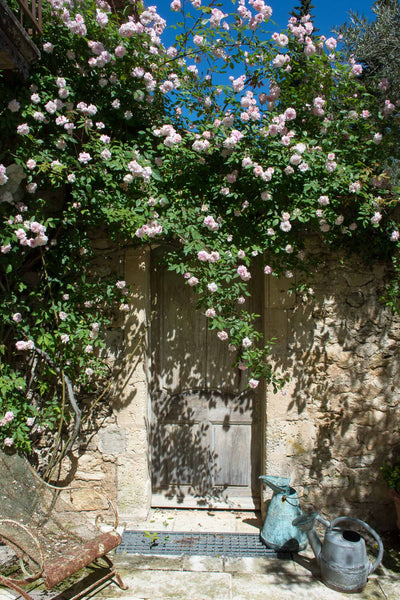
Boxwood thrives in shady gardens and is a staple in traditional French landscaping, valued for its dense, evergreen foliage and versatility. With proper planning and maintenance, boxwood can create a lush and elegant display that is well worth the effort. Its tolerance for partial to full shade makes it ideal for areas where other plants may struggle, while its structured appearance adds timeless appeal.
Symmetry and axial design are hallmarks of classic French gardens, and boxwood is often used to achieve these features. Even in smaller outdoor spaces, such as terraces or balconies, carefully arranged potted boxwood plants can evoke a sense of order and sophistication. They can be used to frame a seating area, line a pathway, or define boundaries, creating a harmonious and balanced aesthetic.
For best results, ensure boxwood is planted in well-draining soil and receives regular pruning to maintain its shape and health. Whether as topiary, hedging, or standalone planters, boxwood is an enduring choice for creating a classic French garden ambiance.
Determining circulation paths and access points is a fundamental step in planning your garden layout. By establishing how people will move through and interact with the space, you create a logical framework that guides the rest of your design decisions. Once these pathways and entryways are in place, it becomes much easier to decide where to plant trees, shrubs, and flower beds, ensuring they complement the flow of the garden and create a harmonious, functional layout. This thoughtful approach is essential for achieving both aesthetic appeal and practicality in your outdoor space.
Views can be beautifully framed through intentional plantings, strategically placed to accentuate the landscape and direct the eye to a focal point. Whether it's a distant horizon, a garden sculpture, or a natural landmark, using trees, shrubs, or climbing plants to create a "living frame" adds depth and intrigue to the space. This technique not only highlights key vistas but also enhances the overall composition of the garden, turning it into a carefully curated and visually compelling environment.
Bonus. Understand your climate zone
France has a temperate climate with distinct zones that shape the gardens and plants typical of each region. The oceanic climate in the west, including Normandy, features mild winters, cool summers, and regular rainfall, making it ideal for lush greenery, hydrangeas, and roses. The semi-continental climate of the north and northeast, covering areas like the Loire Valley and Paris, experiences colder winters and warmer summers, supporting formal gardens with neatly trimmed hedges and espaliered fruit trees. In the south, the Mediterranean climate of Provence and the French Riviera is known for hot, dry summers and mild winters, perfect for gardens with lavender, olive trees, and cypress. Meanwhile, the mountainous regions of the Alps and Pyrénées see colder winters and snow, where hardy plants and seasonal blooms thrive. Understanding these zones helps gardeners choose the right plants for their environment, ensuring their gardens flourish.

Coastal gardens of Normandy
The western and north-western windswept and often rainy region of France has a variety of landscapes including marshlands, dunes, steep cliffs, pine forests, and has given much inspiration to French artists. Rouen is the city of Emma Bovary's bleak home and the famous cathedral that Monet painted in series; while the coastal town of Cabourg is said to be Proust's setting for fictional Balbec; and Cherbourg, although a place of much pluie where an umbrella is necessary year-round is delightful nonetheless in Jacques Demy's The Umbrellas of Cherbourg.
Plants that withstand frosts, harsh winds, and salty air will thrive in the oceanic climate and include rhododendrons, agapanthus, clematis, grasses, sea-hardy flowers, shrubs, lovely old trees, and hundreds of varieties of roses.
Such a romantic mix of trees and flowers in the above photo - note the Medici urns and outdoor chair. Apparently wildflowers and sea-hardy flowers bloom all year (even in winter), but cover gracefully and completely the natural landscape in spring. In winter it is possible to grow daisies, dandelion, shepherd's purse, fumitory and white dead nettle. While in early spring gorse, wild garlic, snowdrops, and early purple orchid primroses appear, followed soon after by wood anemones, bluebells, cowslips, pyramid orchids, oxlips, and campion to list only a few. Plants that are native to the area naturally will thrive and look most harmonious in the landscape. These plants also will provide sought-after nourishment to bees, butterflies, and other local insects.
To shelter from the forceful sea air, the homes of Normandy often feature thatched roofs, exposed timber frames on their façades, and they are wonderfully cozy with inviting open fireplaces.
As the walls are thick, there is plenty of space to accommodate a planter in the window bringing the outdoors in. There are lovely shrub (or herbaceous) borders in the background in the photograph above. Succulents also thrive in the north.
The gardens along this rugged coastline receive plenty of rainfall - lush lawns and huge hydrangeas can thrive in the French gardens of Normandy.
The lush gardens of the châteaux in the Loire Valley
For most of the year, the weather of the Loire valley is moderate and comfortable. The areas to the west are influenced partly by weather from the Atlantic Ocean (more rain and milder temperatures) while the more easterly regions experience a continental climate (hotter and drier summers and colder winters).
The Loire valley is well known for its abundance of châteaux (there are over 1000) and the ordered gardens that grow within. Symmetrical parterres (ornamental flower beds), avenues of lofty deciduous trees, and meticulously espaliered fruit trees are major characteristics of these grand residential gardens in central France.
The large landscapes depicted are organized symmetrically and along geometrical lines and consider depth of space and play with perspective. Plants are often grouped by color and arranged to give a layered look: sky meets tree, tree brushes against clipped hedge, hedge groups flowers, which meet hardscaping, such as pathways of river stone or pebbles. No matter the region, traditional French estate gardens follow principals of design that with a resourceful, inventive mind can be applied to smaller-scale projects.
One will encounter stone statuary while strolling through traditional gardens in France. In these photographs beautiful stone pots are set amongst various clipped trees and topiary that frame ornamental garden beds blossoming with hydrangeas or potagers (kitchen beds).
Parisian style courtyards
The French capital experiences four distinct seasons, often cloudy weather year-round, regular light rainfall sometimes on a daily basis, very cold winters, and fairly mild but short summers.
The historic city of Paris is famed for stunningly beautiful and well-kept gardens like the Tuileries, Luxembourg Gardens, and the Bois de Boulogne. Among these beautiful public green spaces, lie the petite and chic private Parisian courtyards. These intimate spaces welcome herbaceous topiaries in antique planters, decorative plant stands, wrought-iron tables, and charming chairs with lovely outdoor pillows all snugly set between ancient stone walls.
Small outdoor settings invite a morning coffee or an evening aperitif with friends.
Our collection of outdoor Antique French furniture includes small settings well-suited to courtyards.
Rooftop terraces – pied-à-terre
A rooftop terrace is a luxury to make green with topiary bushes, trees, planted urns, pot plants, and creeper clad walls. A lush rooftop is a welcome retreat from bustling city life or village streets.
Geraniums and lemon-scented pelargoniums will bloom all year round on a sunny terrace. A backdrop of potted citrus or fruit trees and shrubs simply furnished with a bistro table, folding chairs, and an umbrella will help create a secluded getaway with an unmistakable French feel. Wrap up in a cozy blanket and experience all of the seasons on the terrace of your own magic mountain.
Sun-drenched Provençale country gardens
The Mediterranean climate in south-eastern France is characterized by hot dry summers, lots of sun year-round, usually mild weather with rain in fall and early spring, and cool to cold winters.
Plane trees, olive trees, cypress pines, lavender, rose bushes, and climbing plants like wisteria, trumpet vines, and jasmine are found in most Mediterranean gardens. Large planted urns, topiary, clipped hedges, arbors, beautiful garden benches, and stone statuary also are to be found.
The sectioned areas of a Provençale garden provide singular interest (such as a potager, parterre, water feature, or outdoor dining furniture). Large country gardens in Provence often will have a vast lawn that meets a vineyard, lavender field, prairie, or olive grove. The fringes where the property meets the countryside can be some of the most poetical parts of the garden.
Exotic cliff-side Mediterranean gardens of the French Riviera
Salty coastal Mediterranean gardens are planted with flowering cacti and slender palms as though they were sculptures. They frame the glistening Mediterranean waters and provide spots of shade in the summer months. As winters are mild in this climate temperature-sensitive plants such as citrus need not fear frosts.
The southern regions are famous for beautiful pots traditionally used to store olives and oil. Ancient Biot jars are the most authentic and are found frequently in the coastal gardens of the Côte d'Azur. These distinctive clay jars add an instant Mediterranean touch to any garden.
The beautiful round, smooth form of the Biot jar evokes the olive. These vessels often are found mounted in a prominent position so they can be admired habitually.
Little garden lamps can be placed nearby to illuminate the jars to enjoy after sunset.
For further ideas we have wonderful collections of both classic antique olive jars and artisan made Biot jars.
Choose the right climatic region for you
Remember to consider the size of your space and its sun exposure and aspect. Your plants will love and reward you by growing healthily and happily if you choose plants suitable to your local climate and soil and pots that can accommodate them. A helpful resource for finding your equivalent weather zone in France can be found here: United States hardiness hardiness zones, which range from one to thirteen (coolest to warmest).
Below are the comparable climate zones of regions in France:
Zone 8 - Paris, Loire Valley, Normandy and the Atlantic
Zone 9 - Provence, The French Riviera (Côte d'Azur)
Et voilà. Thank you for reading eight ways to create your French garden!
Explore our collection of French garden furniture and planters here.
Explore our exquisite collection of French garden décor and add French flair to your garden.
Our timeless biot jars are handmade-to-order in France
Our classic Anduze urns are handmade by artisans in Anduze
Frequently asked questions
1) What are the characteristics of a French garden?
Whether in a large estate, farmhouse, townhouse, or part of the courtyard, all French gardens share some common characteristics, including: some sense of order, whether that be in the form of parterres, bosquets, potagers, or topiary. A number of décor items are found in all types of gardens that give them a quintessentially French feel, including: Anduze urns, Biot jars, Medici urns, outdoor garden furniture, sculpture, and water features.
For more information, read our blog “8 ways to create your French garden” and visit Chateau de Villandry to see some more spectacular French gardens: https://www.chateauvillandry.fr/en/.
2) Which plants that grow in France will grow in the US?
Copying French garden design in the spirit rather than in the letter is the advice of American garden experts. It is best to adopt forward-thinking practices that support sustainability and choose plants that suit your local climate, are native to your local landscape, and are waterwise. Also they will be easier to grow! A helpful resource for finding your equivalent weather zone in France can be found here: United States hardiness hardiness zones, which range from one to thirteen (coolest to warmest).
Planned by Beatrix Farrand (1872–1959), the breathtaking gardens of Dumbarton Oaks draw on some traditional French garden landscape designs, including the Orangery, Swimming Pool and Loggia, the Green Garden Terrace, the Urn Terrace, and the Kitchen Garden. Together with Mildred Bliss (1879-1969), Farrand carefully chose and designed garden ornaments, such as benches, gates, finials, and sculptures. For inspiration peppered with tips for gardening in the US, visit https://www.doaks.org/visit/garden/explore.
Oak Spring Garden, Upperville, VA, designed by Rachel “Bunny” Mellon was influenced in part by the French style. The Oak Spring Garden Foundation is a wonderful resource for gardeners, enthusiasts, and plant lovers.
Paula Deitz is Editor of Hudson Review, a garden writer and cultural critic and I recommend her book, Of Gardens: Selected Essays (Penn UP, 2016), which can be purchased at bookshops. https://www.upenn.edu/pennpress/book/14785.html
3) Jardin à la française: How do I give my terrace or patio a French feel?
“Nothing is more tantalizing or inducive to fantasy than a beautifully trimmed garden with a refreshing fountain in an enclosure that no one may enter,” quips Paula Deitz in Of Gardens (2016). Designed by Russell Page, the beautiful terrace on East 70th Street, part of the Frick Collection, is similar to one he designed on the rue de Varenne in Paris, and Deitz adds, it “evokes the same sense of catching a glimpse of a private French garden.” Visit the Frick Collection website for inspiration on terrace design.
Create a cozy retreat on your balcony, and use ornamental vines as complements to architecture, around a doorway or window. Install a planted urn or lovely garden sculpture. Charming outdoor furniture, made from wicker or wrought iron will prolong lounging time en plein air.
4) Where can I buy French outdoor furniture?
Chez Pluie specializes in French antiques and vintage furniture and is exclusively online, please explore our range of French outdoor furniture via Chez Pluie.
If you visit France in person, be sure to visit the local brocantes and marches to hunt for some good finds. You can arrange shipping with Chez Pluie.
Related Posts:
Ten ways to create the Patina Farm aesthetic

The most beautiful French Gardens - Dominique Lafourcade
The Biot Jar; An Ancient French Tradition

The Anduze Urn; Timeless Elegance
Six ways to create your modern farmhouse kitchen
Seven ways with demijohn bottles

Pam Pierce: classic decor ideas











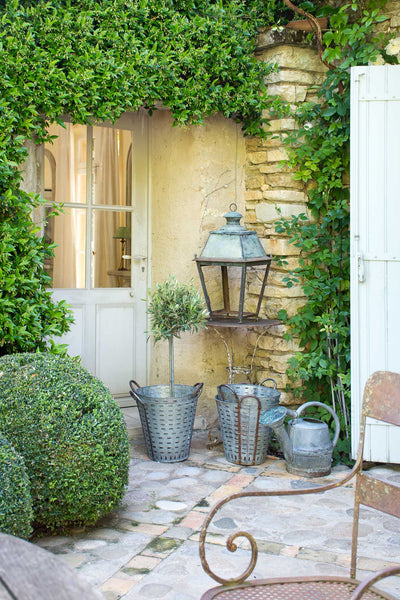


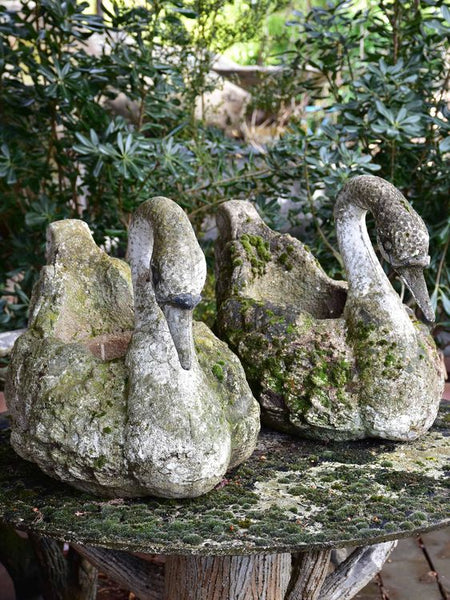


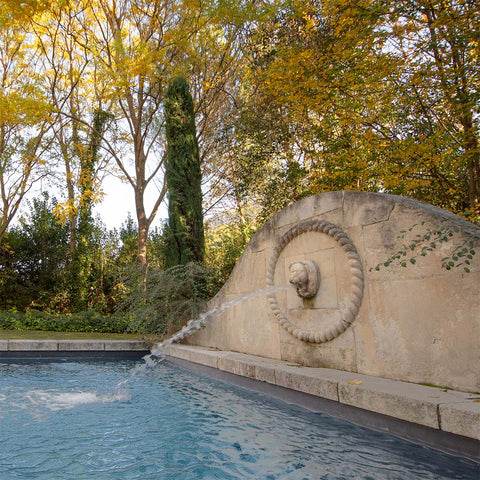







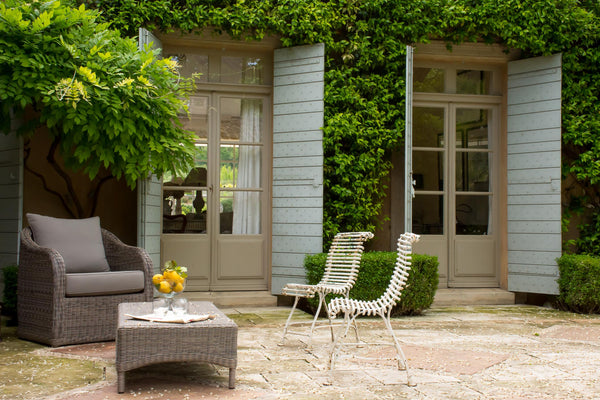








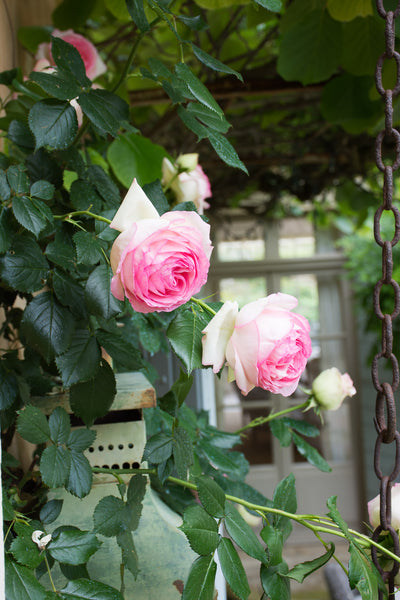















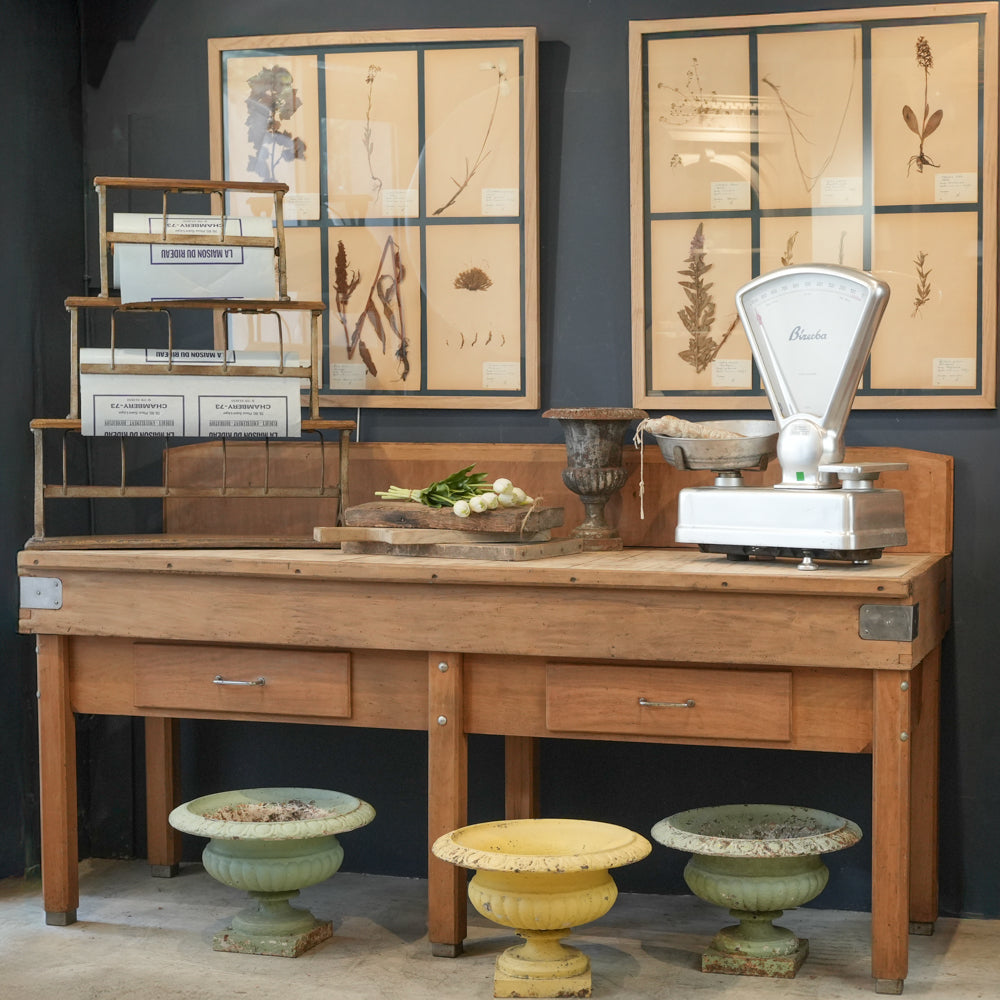

10 comments
Beautiful!
Berta T Mitchell
Wonderful website. A lot of useful info here. I am sending it to several friends ans additionally sharing in delicious. And certainly, thank you in your sweat!
Bondi Landscapes
Thank you for your very informative and beautiful article. I feel inspired to create my own french courtyard now! I appreciate the way you have broken down the specific elements of a french garden. Your article has been very helpful. Merci!
Jennifer
Thank you for sharing your beautiful pictures and your fountain of knowledge.
Renee
Everything was Absolutely Beautiful!
Since I am half French I can see why I am attracted to Everything. It was like putting on a Shaw. Merci
Pamela Thiolet/Theolet
Delightful and inspiring reading, so romantic the French influence, whether
old or new, one of the few styles where very old and worn looks beautiful.
So lovely.
Dell Stone
Awesome, best ideas for french look an garden
Dawid
What is name of climbing rose? Thanks
Nancy Brantley
Many thanks Kirsten for your kind comments and reference. Yours sincerely, Susannah Cameron
Susannah Cameron
Wonderful images and commentary on French garden style! I notice you used my photograph of the charming garden at La Paternelle. Please provide a link in the photo or caption to this original content in case your readers would like to know more about the garden: http://www.ladolcevitacalifornia.com/2014/01/translations-creating-wonderful-whimsey.html Merci!
Kirsten Hoenyman
Leave a comment
This site is protected by hCaptcha and the hCaptcha Privacy Policy and Terms of Service apply.